Author: Dewhales Research Source: substack Translation: Shan Ouba, Golden Finance
1. Introduction: What is FHE, its history and applications
FHE stands for fully homomorphic encryption, which is an encryption scheme that allows calculations to be performed directly on ciphertext without decryption. This means that the encrypted data remains encrypted throughout the calculation process, the calculation results are also encrypted, and no party can access the plaintext data at any time. FHE supports calculations on encrypted data, including machine learning and artificial intelligence analysis, allowing scientists, researchers, and data-driven enterprises to extract valuable insights without decrypting or leaking the underlying data or models. Fully homomorphic encryption is the strongest form of encryption, but it has a big disadvantage and requires a lot of computing power.
In fact, there are many types of FHE: BGV, BFV, CKKS, FHEW, NuFHE, and TFHE. Homomorphic encryption (HE) initially gained momentum slowly over the first three decades after being proposed in 1978. FHE, in its current form, came to light in 2009 when Craig Gentry proposed a method to achieve fully homomorphic encryption, although the system introduced noise with each operation. Later, a modified version with smaller ciphertexts was proposed, but the most popular scheme was proposed by Zvika Brakerski and his team, which provided improved security and performance compared to the earlier FHE approach. After several successive iterations—BGV, BFV, and CKKS—GSW was born, from which FHEW (introduced in 2014) and TFHE (introduced in 2016) were developed. Chillotti, Gama, Georgieva, and Izabachene reduced the latency of each gate bootstrapping operation to less than 0.1 seconds. Since then, the scheme has incorporated programmable bootstrapping into its process, accelerating FHE and making it suitable for most use cases, including web2 and web3 applications.

The final result so far is Zama's TFHE-rs, which extends the original TFHE functionality to support integer programmable boot. And, TFHE-rs is used in the current Privasea implementation.
FHE use cases:
Cloud computing: FHE brings huge benefits to cloud computing by allowing users to store and process data in encrypted form on remote servers. This means that users can leverage the massive computing power of the cloud while keeping their data secure and private. It’s a win-win for all parties involved.
Financial Services: Financial services can also leverage the power of FHE. By securely processing financial data, FHE allows financial institutions to perform sophisticated analytics on encrypted data. The best part is that customer privacy is maintained throughout the process.
Machine Learning: FHE can greatly facilitate machine learning by training models on encrypted data. This enables organizations to harness the power of machine learning while keeping their data secure.
2. Privasea Overview
The Privasea AI Network provides a solution to the challenges associated with artificial intelligence data privacy. The network represents a cutting-edge architecture that combines fully homomorphic encryption (FHE) with blockchain-based incentives, addressing growing concerns related to data privacy and meeting the growing demand for collaborative AI computing. The Privasea AI Network takes FHE from theory to application in four layers: application layer, optimization layer, arithmetic layer, and primitive layer. The network provides general and customized solutions to bridge the gap between user privacy and distributed computing resources in AI processing, covering all four layers of FHE.
A key goal of the Privasea AI Network is to ensure compliance with data protection regulations, including the European Union's stringent General Data Protection Regulation (GDPR). These regulations impose strict requirements on the collection, processing, and storage of personal data.
2.1 Network Participants:
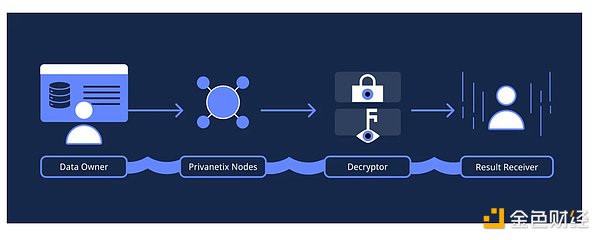
Network users (data owners, result receivers): initiate machine learning tasks, provide data securely, and interact with the network to obtain decrypted results.
Privanetix nodes (computing nodes): as service providers in the Privasea AI network, provide computing resources for privacy-preserving machine learning tasks.
Decryptors: Dedicated participants who ensure the secure decryption of encrypted results generated by Privanetix nodes. They collaborate with network users to decrypt and interpret the final results of machine learning tasks, ensuring the privacy and integrity of the decrypted results.
2.2 Privasea Architecture:
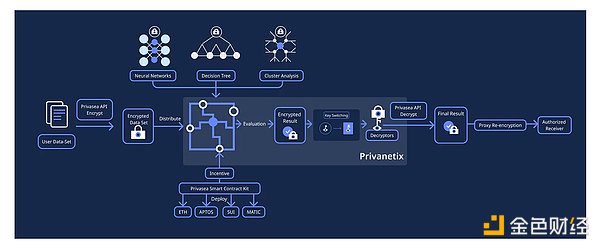
The Privasea AI Network consists of four main components: HESea Library, Privasea API, Privanetix, and Privasea Smart Contract Suite.
HESea Library: This component forms the foundation of the Privasea AI Network, hosting a range of efficient implementations of popular fully homomorphic encryption schemes, such as TFHE, CKKS, BGV, BFV, etc. The HESea library provides developers with access to a wide range of functionality.
In addition, according to GitHub, Privasea also includes several other components of Zama AI to provide state-of-the-art FHE solutions for blockchain and AI:
Concrete: An open source FHE compiler (updated to TFHE-rs) that simplifies the use of fully homomorphic encryption (FHE). It allows Python programs to be converted to their FHE equivalents. Concrete is useful for developers who want to create advanced applications that accept encrypted input and produce encrypted output.
TFHE-rs: A pure Rust implementation of TFHE for boolean and integer operations on encrypted data. TFHE-rs is designed for developers and researchers who want full control over TFHE functionality without having to worry about the underlying implementation details.
2.3 Privasea workflow:
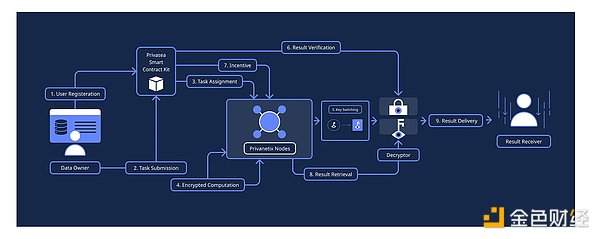
Users create accounts, set up machine learning tasks, encrypt vectors locally through the API interface of machine learning applications, and generate exchange keys locally.
Users can then submit encryption tasks to the Privatenix network and pay for services through blockchain.
The Privatenix node receives and performs encryption tasks in the user's encryption domain, and then transmits the encrypted results to the decryptor's encryption domain using the user's previously generated handover key.
Once the work is completed, Privanetix sends the results to the decryptor and gets paid
Next, the decryptor decrypts the results using their client key and sends the decrypted results to the network user using a proxy re-encryption (PRE) scheme.
2.4 Secure KYC Use Case Workflow:
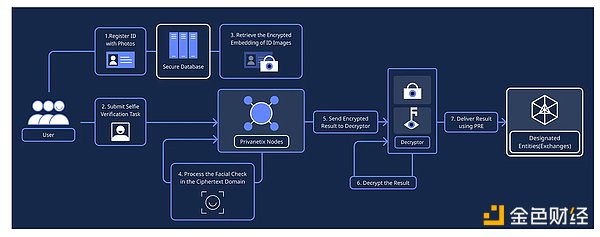
1. Register ID card with photo: User provides ID card, including photo. Client uses feature extraction algorithm to extract facial features from ID card photo
2. Submit selfie verification task: User takes a selfie with camera or mobile device, and client uses the same feature extraction algorithm as ID card registration to extract facial features from the selfie image.
3. Retrieve the encrypted embedding of the ID image: The designated Privanetix node retrieves the encrypted ID embedding associated with the user from the secure database.
4. Process the face check in the ciphertext domain: Leveraging FHE capabilities, the Privanetix node performs computations on the encrypted ID and selfie embeddings, such as calculating the distance between them. The Privanetix node compares the distance to a predefined threshold to determine the similarity. The result is retained in the ciphertext domain.
5. Send encrypted results to the decryptor: The Privanetix node sends the encrypted Boolean result to the decryptor for further processing.
6. Decrypt and extract the result: The decryptor, who has the private key, decrypts the received result to obtain the final check result (e.g., yes or no).
7. Result Delivery: The decryptor uses proxy re-encryption (PRE) or other suitable methods to securely deliver the final result to the designated agency or entity that needs it.
3. GitHub
Above we have reviewed some of Zama AI's repositories, now let's take a look at some of the proprietary Privasea repositories. The first thing that catches your attention is that the last update to the Privasea repository was in July 2023. This is probably because the competition around FHE and AI/ML task assignments in the field is very fierce at the moment, so the team does not release updates to keep their development alive.
Privasea-general is the main Privasea repository, which contains multiple open source packages. These packages include HESea_lib, an advanced fully homomorphic encryption (FHE) library that provides developers with powerful, flexible, and easy-to-use secure computing tools. or Privasea-Miscellaneous, which contains source data that can be used in other PrivateSea repositories.
HESEA_Lib - HESea is a cutting-edge fully homomorphic encryption (FHE) library that provides developers with powerful, flexible, and easy-to-use secure computing tools. Built with state-of-the-art cryptographic techniques and optimized for high performance, HESea is ideal for a wide range of use cases. HESea provides a variety of FHE schemes, including TFHE, CKKS, BGV, BFV, and more, allowing users to perform computations on encrypted data without decryption. This ensures that sensitive data remains secure and protected from privacy leaks and security threats.
Comparison_demo - This is a demonstration of ciphertext sorting using the HESEA library. This demo program encrypts the plaintext sequence to be sorted into the corresponding ciphertext sequence and sorts the sequence by comparing the ciphertext sequence. The program then decrypts the ciphertext sequence and outputs the sorted plaintext sequence.
dinn_demo - This is a demo for secure handwritten digit recognition using the HESEA library. It represents a privacy-preserving deep learning approach using a TFHE encryption scheme. The main advantage of DINN is that it achieves competitive accuracy while maintaining normal operating efficiency through the innovative use of discrete neural networks. These networks quantize weights and offsets, reducing the complexity of the underlying computations and simplifying the initial TFHE bootstrap. As a result, homomorphic estimation is further improved, resulting in increased efficiency.
4. Token Economics
PRVA token is a utility token in the Privasea Al network and plays a vital role in facilitating transactions, incentivizing participants, and enabling on-chain governance. It also acts as a medium of exchange, enabling users to access privacy Al services and unlock various features within the ecosystem. The value of the PRVA token is primarily driven by demand for network services, which include privacy-preserving machine learning and other Al-based capabilities.
Specifically, the PRVA token plays the following roles in the ecosystem:
- Transaction facilitation
- Incentives and rewards
- Governance and voting
- Staking and network security
- Access to exclusive features
Token distribution:
Mining/Staking (45%)- Will be allocated to staking nodes within the project that provide fully homomorphic encryption (FHE) and other privacy services.
Team Allocation (10%)
Supporters (20%)
Marketing and Community Development Allocation (15%) - These tokens will be used exclusively for marketing and community development initiatives.
Reserves (6%) - This category is primarily for projects that cannot be planned for, such as future regulations that need to be met or licenses that need to be applied for.
Liquidity (4%) - This liquidity is critical as it ensures that participants are able to enter or exit their positions without causing large price fluctuations, thereby promoting the growth of the market.
5. Team
LinkedInCEO David Jiao is an experienced entrepreneur with a strong background in complex system development, having worked as a software engineer at Simplight Nanoelectronics in 2010 before joining Cybercom Group. From 2015 to 2020, David was co-founder and Chief Product Officer of Golden Ridge Robotic AB, a startup R&D company focused primarily on Cyber-Physical home robotic systems. In parallel, he was involved in software development at Volvo - as a system designer at Volvo, I was responsible for designing and prototyping system features for vehicle configurations in Volvo's new SPA2 architecture. In 2021, he launched Nulink to provide PRE+ZK technology for decentralized applications via APIs. Additionally, David’s experience at Volvo enabled Privasea to participate in joint projects with RISE (a Swedish research institute) and Alkit Communications AB for the automotive industry.
Ting Gao, LinkedInPrincipal Research Scientist - Has a strong background in applied mathematics and mathematical modeling: since 2010 he has been a researcher at the Illinois Institute of Technology, since 2015 he worked as a data analyst and data scientist at M3, and then as a ML engineer at Twitter. Since 2021 he is an Assistant Professor of Applied Mathematics, Stochastic Modeling, Deep Learning and its Applications in Mathematical Finance at Huazhong University of Science and Technology
Alex (R) Gaidarski, LinkedInGrowth Manager - Has extensive experience as a system administrator since 2006, which makes him a marketer with a technical inclination. Prior to Privasea, he worked at NuiLink as a member of the marketing team with David Jiao.
Zean Darren, Community Development and Management, LinkedIn - Has extensive experience in community management, having served as an ambassador for Manta, Polyhedra, Tanssi Network, and as a moderator and assistant at Arcomia and Story Chain.
6. Partnerships, Integrations and Applications
Privasea’s current main real-world application is ImHuman, which is available on Google Play and AppStore. It is an implementation of PoH (Proof of Humanity) technology that confirms human identity and protects your digital presence from robots and AI imitation. In this application, identity confirmation through facial biometrics is personalized human identity proof through NFT. Biometric data is networked through cryptographic vectors on the user’s device. These vectors are then securely encrypted using the user’s client secret key and sent to Privasea’s secure web server. Privasea is currently planning to implement its PoH solution in Linea, Movement, Gate, and integrate with Telegra, /Discord/Reddit.
Example of integration with TG Robot:
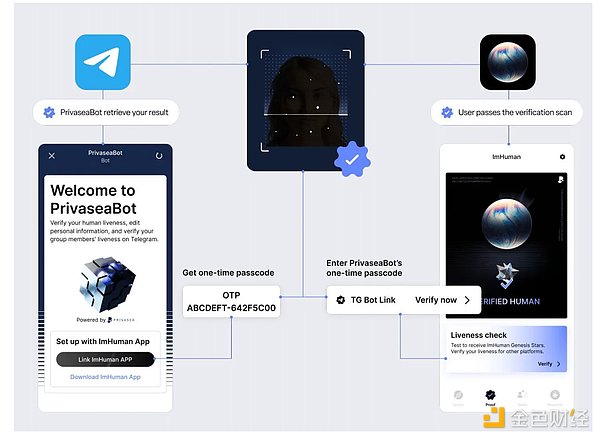
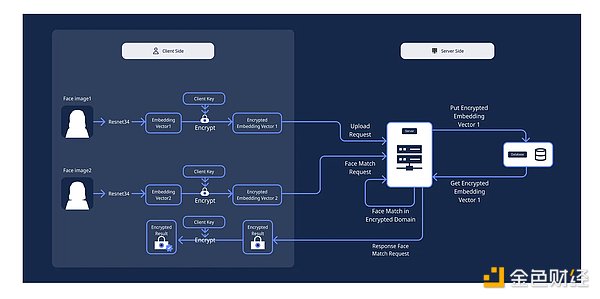
Mind Network is a pioneer in decentralized zero-trust data lakes. Privasea is currently building a fine-tuned library optimized for core operations of fully homomorphic encryption, providing efficient and convenient solutions for web2 and web3 clients. Mind Network, on the other hand, focuses on secure data-driven smart contracts and AI with encrypted data. One of the key aspects of this collaboration is that Mind Network will integrate Mind Network's FHE data lake into Privasea's AI network.
BNB Grienfield - Combining data management with the potential of decentralized finance (DeFi) in BNB Smart Chain (BSC). Privasea AI Network and BNB Greenfield have joined forces to change the landscape of data storage and privacy. Privasea's FHE technology will enable persistent encryption of user data on the network. In addition, developers on the BNB Greenfield platform can seamlessly perform calculations with encrypted data, covering operations such as data statistics, logical analysis, and machine learning model evaluation, without having to delve into the complex details of encryption methods, including the ability to leverage Privanetix's powerful nodes.
Ton Network - Privasea has launched Secure LivenessCheck Bot, a solution from TON Netwok that aims to redefine user authentication by leveraging advanced facial recognition technology combined with fully homomorphic encryption [FHE].
Pri-Auto is a project for the sustainable automotive industry that the Swedish Vinnova Fordonsstrategisk Forskning och Innovation (FFI) has chosen to fund in 2023. Under the Pri-Auto project, Privasea will build infrastructure to create a secure data source for the automotive industry and enable data sharing between multiple parties such as OEMs, MaaS and insurance companies through smart access rights management. For this project, Privasea is working with RISE, a Swedish research institute, and Alkit Communications AB, a provider of data collection services to OEMs such as Volvo Group and Volvo Cars.
7. Backers
Privasea has received $5 million in investment commitments from backers such as Dewhales Capital, Binance Labs, Gate Labs, OKX Ventures, MH Ventures, K300 Ventures, QB Ventures, Crypto Times, Basic Capital, DuckDAO, and some business angels from the industry such as Zakaria (zak) Aves and Luke Sheng (from Chainlink).
8. Conclusion
By solving efficiency issues and focusing on improving existing algorithms, Privasea paves the way for the widespread adoption of FHE, ensuring a future where data security and privacy can coexist in this data-driven world. Their solution allows users to take advantage of the multiple distributed computing resources provided by blockchain while maintaining full control over data and models when processing AI. As the world becomes more and more complex, web3 and AI are becoming more and more closely connected.
 JinseFinance
JinseFinance











